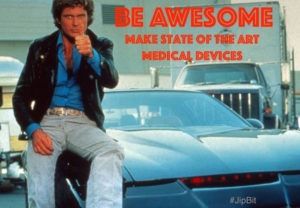Make state of the art medical devices
The new European Union Medical Device Regulation will protect patient safety by requiring healthcare companies to make products that are “state of the art,” a term that’s easily misunderstood. This law is best explained with an example from cars, comparing today’s state of the art with to the 1980’s television series Knight Rider, where David Hasselhoff fought crime in a talking, self-driving car.
Knight Rider
- Seatbelts
- Brake lights
- Air bags
- Child safety-seat securing hooks
- Side-impact safe doors
Similarly, some medical device features seem like good ideas but aren’t “generally accepted state of the art” because there’s not enough evidence that they reduce risk to patients. The MDR requires companies to continuously review competition and public safety reports to prove that they’ve reduced risk to patients As Far As Possible, which includes having state of the art products.The concept of regulations that improve safety may be more easily visualized with cars. For example, in 2016 an estimated 16,000 lives were saved in the U.S. thanks to seat belts. But, healthcare is a bigger risk than automobile accidents, with 80,000 – 250,000 unnecessary deaths in the U.S. each year due to healthcare errors. Similar data worldwide led to the EU MDR, and the U.S. is considering similar healthcare reform.Medical device safety is more complex than car safety, and state of the art is a combination of design, manufacturing process, surgeon training, etc. I’ll demonstrate this with a few examples.
Spine implants: new technology, but not state of the art
 New medical technology is not always state of the art. For example, motion preserving spine implants are new technologies, but may add risk to patients therefore are not generally accepted state of the art.
New medical technology is not always state of the art. For example, motion preserving spine implants are new technologies, but may add risk to patients therefore are not generally accepted state of the art.
Before motion-preserving spine implants, surgeons used spine-fusion implants to prevent spinal vertebra from moving, usually to protect the spinal cord, sometimes to reduce pain (this is a controversial topic – learn more.) A concern developed that fusing one set of vertebra caused more motion in other vertebra which led to problems in 6 to 8 years. In the 2000’s several start-up companies developed “motion preserving” spine implants to replace fusion devices.


Manufacturers settled class action lawsuits and national health insurance programs refuse to pay for the procedure, especially because it’s 10X more expensive than previous spine implants. Long-term studies of patients with motion-preserving implants haven’t shown benefits that justify the risks or costs. In other words, new spine technology does not mean it’s state of the art healthcare, it could be adding both risk and costs to public healthcare.
Previous medical device regulations did not enforce state of the art safety, which is why products that add risk and cost are still on the market. Unfortunately, most patients rely on their physicians to advise them despite many surgeons are unaware of the risk/benefit analysis or cost. And, some physicians are incentivised by medical device companies to suggest the more expensive implants. All of this is why the MDR will hopefully benefit society.
Robotic spine surgery: New and effective, but still not state of the art
 Some new technologies can be safe and beneficial but are not state of the art because not everyone’s infrastructure is ready for new technology. This is the case with robotic assisted spine surgery.
Some new technologies can be safe and beneficial but are not state of the art because not everyone’s infrastructure is ready for new technology. This is the case with robotic assisted spine surgery.
Many spine surgeries use robotic surgery or some type of nerve-monitoring technology to protect patients’ spinal cords during surgery. This new technology is generally considered beneficial, therefore would almost be considered “state of the art” by the MDR definition, but it is not because it is only true in specific cases where the hospitals have sufficient infrastructure and surgeons are sufficiently trained and experienced. The EU MDR applies to all countries in the European Union, therefore to be state of the art the technology would have to apply to the infrastructure and training of almost 30 European countries.In other words, a company can sell nerve-monitoring equipment to hospitals based on improved results, but not all spine implant companies would be held to the standard of robotic surgery outcomes because these new technologies aren’t yet “generally accepted state of the art.”
Hip implants: Old and ambiguous
Hip implants seem simple at first. One part goes into the acetabulum of your hip, the other part into the femur of your leg, and there may be a plastic liner.

Consider when Sulzer Orthopedics shipped 35,000 hip stems with toxic oil in them, resulting in thousands of patients suffering.

Over 9,000 Sulzer hip stems were implanted and 4,000 failed before the cause was identified. Thousands of people suffered eroding bones, requiring another surgery and impacting their ability to walk for the rest of their lives. Over $1 Billion in lawsuits bankrupted Sulzer, but patients said they’d rather walk normally than have received insurance money.
Oh shit, now what?
In other words, your product’s complications must be less than that of competitors and alternative treatments, however you achieve that.
Companies must submit two documents supporting their product, post-market surveillance and clinical data. Post-market surveillance is current, real-world data on the safety of each product or group of products. Clinical data includes competitors’ products, safety data, and alternative treatments; post-market surveillance includes the manufacturer’s product safety. State of the art is demonstrated by comparing clinical data to post-market surveillance.For now, companies must do their best to find clinical data publicly. In the future all companies and the general public will have access to this information online. The MDR is creating new agencies that will look at this data and see if medical device features truly improve patient safety; if so, those features will become state of the art. This is similar to how governments currently treat automotive safety.
Government regulations require state of the art in new cars but do not enforce all innovations until there’s enough evidence that these features impact public safety. Agencies such as the U.S. National Highway Traffic Safety Administration (NHTSA) keep consumers informed about new technologies that aren’t required.


Summary
State of the art is complex, based on a combination of product features, manufacturing processes, training, and the realities of hospital systems in diverse countries.The MDR will create an online database, EUDAMED, with transparent, public data on medical device safety. That data will be used to determine “state of the art,” but until then companies must seek and use published research data.
Learn more
- Oriel STAT-A-MATRIX an international organization since 1968 (I consult with Oriel)
- Qunique, based in Switzerland and expanding internationally
- Jason (me)

